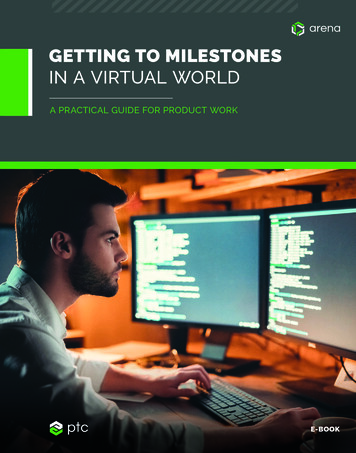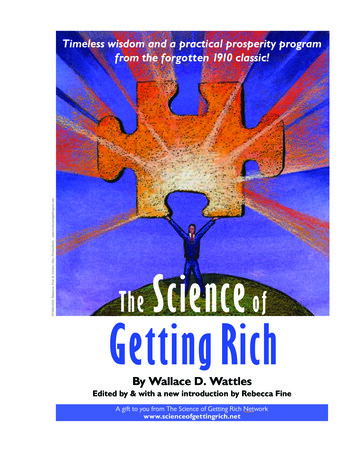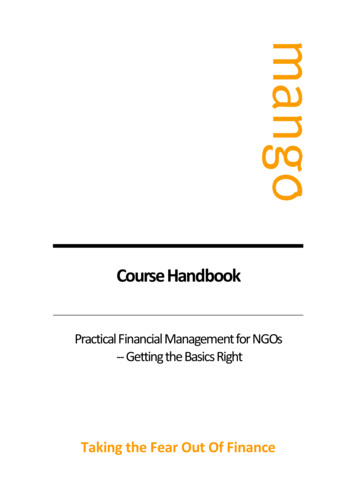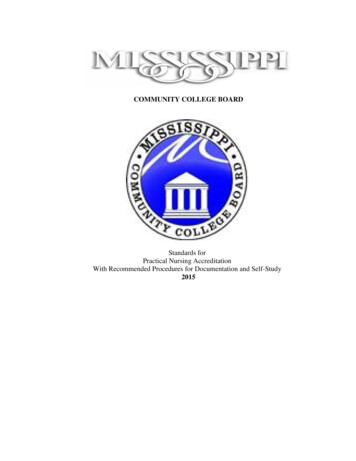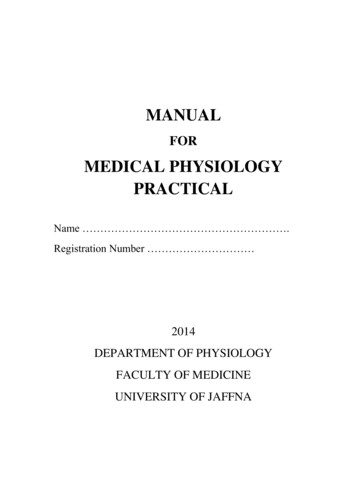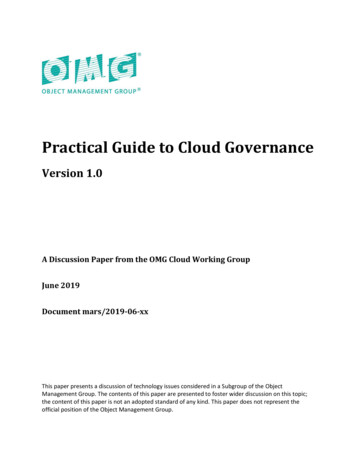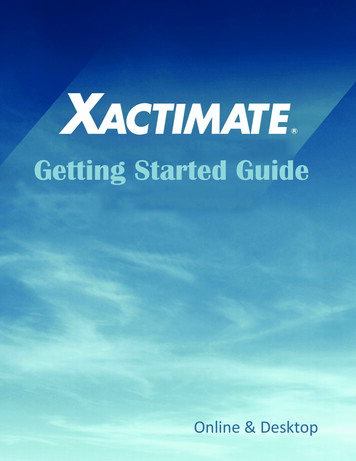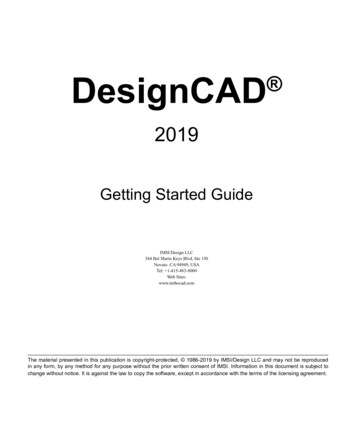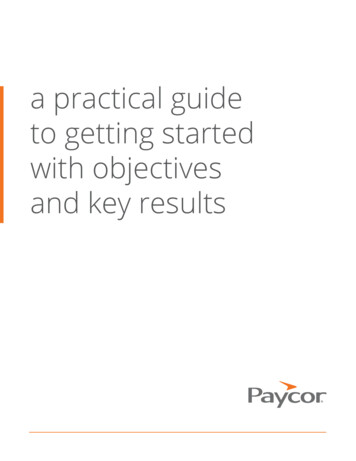
Transcription
a practical guideto getting startedwith objectivesand key results
ContentsSECTION 1 - GOAL SETTING: AN INTRODUCTIONObjectives and Key Results, an introductionEvolution of goal settingCreate in-sync, intuitive teams with direct ownership over successWith a 3 month cadence,s create regular culture checksSECTION 2 - WRITING OKRSOWhats are and are notRolling out OKRs: best practicesUsing key performance indicators in your OKRsGrading and assessing OKRsGreat OKRs rely on a great planning processpage 2 of 26Chat with.com
goal-setting: anintroduction
Objectives and Key Results,an introductionOBJECTIVES AND KEY RESULTS IS A GOAL-SETTINGMETHODOLOGY DRIVEN BY OUTCOMESIn business, OKRs are used to guideUsing outcomes instead of tasks as a driver,OKRs encourage accountability in every stepof achieving success through metricOKRS OCCUR RHYTHMICALLYFollowing a cyclical planning cadence, thefocus of goals moves from tasks to results,keeping priorities and everyone’s thinkingA SUPPORTIVE ATMOSPHERE IS CREATEDwhat a great OKR is and how to write them,as well as what a great planning processlooks like so you can get started withgoal-setting in your own team!page 4 of 26EVERYONE IS ACCOUNTABLEChat with.com
Evolution of goal-settingGOAL-SETTING ISN’T NEW. THERE’S ALWAYS BEENTEAMS WORKING TOWARDS PRIORITIESMANAGEMENT BY OBJECTIVESalongside coaching environments, to highapproach taken to goal-setting, the endgoal-settingmodelthatintroducessolutions to ensuring a more real-timeHere’s an overview of how goals haveS.M.A.R.T GOALSmeasurable, attainable, rel v nt andtargets, areas of improvement become easyevaluationslinked to tasks, not goaland department leads are responsible forline of sight into career growth forcreated in a targeted fashion to beassignable to an employee to accomplish, inpage 5 of 26Chat with.com
VALUES-DRIVEN OUTCOMES CREATE ANEMPLOYEE-DRIVEN ATMOSPHEREcommunicationnolongerbecomeassume setting goals once a year is anbecome an inclusive place where the inputenvironment where coachinghas a strongOKRS INCREASE TEAM AGILITYshould set goals independently ofoneanother based on their directresponsibilitiesCross-functionalpage 6 of 26teamsuccessGOALS ARE DECOUPLED FROMPERFORMANCE BONUSESEveryone works harder and aims higherwhen goals become decoupled frommetrics so employees are able to focus onandChat with.com
Create in-sync, intuitive teams withdirect ownership over successKEEP TEAMS FOCUSED, EMPOWERING INDIVIDUALSTO CONTINUOUSLY GROWALIGNED TEAMS INCREASE VISIBILITYWith OKRs, you don’t have to wait until thingsbreaks the assumption that performanceneeds to be “managed,” moving focus onEVERYONE’S PERSONALLY INVESTED ANDACCOUNTABLE FOR SUCCESSnumbersworking to achieve, employees becomeEveryone is able to see how priorities areprogressing at an individual level, all the wayandmoretimeusingtheirworks towards value-driven goals; everyoneplatform for ongoing dialog in emconversationstiedOKRs take the guess work out of how eachincreased visibility, each team can createpage 7 of 26Chat with.com
With a 3 month cadence, OKRscreate regular culture checksA PROCESS FOR DELIBERATING IF NEW IDEASSHOULD BE ABSORBED INTO EXISTING PRIORITIESOKRS USE METRIC INDICATORSWhen an objective has measurable key results,OKRs force constant deliberation, keeping yourALIGNED TEAMS COMMUNICATE BETTERare positioned to know what is important to themeans frequent assessment on priorities andthroughout the year without having to getpage 8 of 26Chat with.com
writing OKRs
A GREAT OBJECTIVE CLEARLY ANSWERS,“WHO IS RESPONSIBLE FOR WHAT?”When employees clearly understand what isObjectives are single sentences that describecurrent business priorities in the language andlooking for the sweet spot between pushingyou and your team to do bigger, innovativethings and where you can still move forwardIf you’re saying, “This seems doable if we reallypush ourselves this quarter ” - you’re doingpage 10 of 26Chat with.com
What OKRs are and are notEVERY ORGANIZATION MIGHT HAVE A DIFFERENTINTERPRETATION, BUT THE APPROACH STAYS THE SAMEOKRS ARE NOT.results is to measure and gauge movementhelp teams spend less time being distracted- General actions you plan to takeINSTEAD, THEY ARE.Reminders why you do what you doWritten so anyone can understand howyou’re contributing to business strategiespage 11 of 26Chat with.com
Rolling out OKRs: best practicesBEST PRACTICES INFORMING THE ROLLING-OUT OFOKRS TO YOUR TEAMSETTING THE RIGHT CADENCEcontinuous basis, not just at the end of theTEAM AND INDIVIDUAL BEST PRACTICESevery three months beginning in January, islevel can always be stretched quarter overquarter if the impact on success of anachievable in a three-month-cycle that areconversations that answer what successmeans in relation to how each team needsWhile quarterly is recommended, it isimportant the cadence matches the culturetransition from annual assessments to moreAWARENESS ISN'T VALUABLE - IT'S HOWYOU WIELD ITpage 12 of 26Chat with.com
OBJECTIVES EMPOWER COLLABORATION ANDCROSS-FUNCTIONALITYKEY RESULT CRITERIAresults focus on measuring an end result ofOBJECTIVE CRITERIAhow do I know ifI have achieved my outcome?”sense of collaboration with a great objectiveAN EXAMPLE OF A GREAT OKRcan see that and see how they can focusa sentence, there should be a clear subject,what am I workingtowards without focusing on the tasks?”page 13 of 26Chat with.com
management and OKRsOKRS ARE THE OUTCOME OF ALL THOSE TO-DOSIT’S THE RESULTS THAT MATTERroadmap that lead to the results you trackmoves conversations away from, “what steps(task) am I going to take to complete thisoutcome,” to, “what am I expecting to achieve ifI successfully complete this objective? What”by splitting time on fewer things andencourage discussion on how one person’sTRANSLATING TASKS INTO OKRSOnce you’ve established what result you’rehoping to achieve, think to the supportingprojects that you’re going to perform to getpage 14 of 26day-to-day, as they are short bursts that helpTASKS CAN’T BE GRADED OR ASSESSEDmaking tasks a key resultthey can’tbedid you hit your target? yes or“how did you perform, whatroadblocks you faced, did youhigh? Were you supported inyour results?”Chat withno?” notwere theaim tooachieving.com
OBJECTIVE: POTENTIAL CUSTOMERS UNDERSTAND OURINDUSTRY’S BEST PRACTICEKEY RESULTPROJECT #1Webinar on best practicesTask 1: Create campaign to engage customersTask 2: Execute webinar, analyzing resultsPROJECT #2Write 5 blog posts per monthTask 1: Write content on industry trendsTask 2: Write campaigns to send to existing leadsKEY RESULTthrough our spotlight storiesPROJECT #1Write spotlight storiesTask 1: Identify highly engaged customersTask 2: Write and publish spotlight storyPROJECT #2Engagement campaignsTask 1: Create engagement campaignTask 2: Ship campaign, monitoring resultspage 15 of 26
Using key performance indicatorsin your OKRsFOCUS ON THE RIGHT METRICS FOR GROWTHINCORPORATING THE RIGHT METRICSBEST PRACTICESinsights move conversations from actionswill keep employees engaged because youmeans teams can assess success patterns toreally measure the most valuable aspects ofhow you’d like to move away or towards yourto make sure it is a valuable metric to thesake of abiding by the “metric-driven” aspectif you have to wait more than the quarter topage 16 of 26
threshold metricsEVERY METRIC USED SHOULD MATCH YOUR TEAM’SCULTURE AND PRIORITIESbusiness, measurable, attainable in the givencycle of the objective, relevant to your OKR,BASELINE METRICSTHRESHOLD TARGET METRICSPOSITIVE AND NEGATIVE METRICSif your average usability score for a corecreating a range of metric-centric goals thatpage 17 of 26
Grading and assessing OKRsCREATE CLEAR EXPECTATIONS USING A GRADESCHEMA TO ASSESS YOUR OKRSA ONE SIZE FITS ALL GRADING APPROACHIS NOT THE BEST APPROACHTHE TRADITIONAL 0-1 KEY RESULT SCALEWhen grading OKRs the traditional way, thechallenging, so every individual should beimportant to establish a grading scale beforecommitting to an OKR to ensureRED OR GREEN: MEETING EXPECTATIONSsign you need to re-evaluate whether theobjective is still worth pursuing, or rethinkat the end of the quarter, did you meet thecommitted to?page 18 of 26grade depends on the circumstances of yourbecause priorities shifted halfway through
and business purposeA CLEAR PURPOSE AND ALIGNED TEAMS IS ANENGAGED TEAMCreating objectives can be done at any level,but an important component of making anobjective great is how it aligns with otherA TOP-TO-BOTTOM PROCESS, WITH AFOCUS ON BOTTOM-UP EFFORTSEveryone is driven by business prioritieskeepsandcorevalues alignmenteveryone’sESTABLISH A CLEAR DRIVING PURPOSECreating great OKRs depends on how wellyour team as a whole does in identifyingunsure what the entire support team iswon’tknowwhat’sapriorityifthebeing driven by core values and businesspriorities, creating great OKRs means thatIt’s important to link your objectives to a corevalue or purpose, to ensure you’re beingpage 19 of 26
performance evaluationsDECOUPLING GOALS AND PERFORMANCE ENABLESVALUE INNOVATIONOKRs, when done great, are a tool formotivating and aligning people to worknot designed to be used as a weapon againstLinking incentives to goal-setting can lead tocompetition over collaboration, quantityover quality, and less innovative, challenging,LINKING THE TWO? HERE’S A FEW BESTPRACTICES TO KEEP IN MINDHave oversight over everyone’s OKRs toensuretheymeetcompany-wideLink bonuses not solely to OKR performance,but other attribute criteria, such asprofessionalism brought to work, skillsDon’t base bonuses solely on whether or notdiscussion about performance, but don’t letthem be the deciding factor for whether apage 20 of 26
creating alignmentand a quarterlyplanning process
Great OKRs rely on a greatplanning processANY GREAT PLANNING PROCESS PLACES EMPHASISON REFLECTION CONVERSATIONSTHERE HAVE TO BE CONVERSATIONSESTABLISHING A PLANNING TIMELINEo create OKRs, commit to new ones,know what the current priorities are,discussionsonwhathappenedpreviously, what was learnt, andSTEP 1:bothretroactively, as well as in the future tomake sure course corrections are enabledSTEP 2:OKRs are inherently collaborative, meaningSTEP 3:the planning process’s end needs to focuson how each team is going to be supportingthe other, what resources are going to beneeded, and ask each other any questionson clarity if a team’s OKRs are unclear or notTIMELINE:page 22 of 26TIMELINE:TIMELINE:STEP 4:TIMELINE:
DISCUSSIONS FOCUS ON RISKS, BLOCKERS, ORRESOURCES NEEDED TO SUPPORT THE OKRSstarting with OKRsis to ensure you’resupposed to bechallenging, but also realisticREFLECT ON PERSONAL COMMITMENTSEvery great planning day incorporates adiscussion where everyone gets asked ”canyou commit to all of this?”ASSESS CROSS-FUNCTIONAL GOALSimportant, especially for operational goalsshould be no lack of understanding on, forpage 23 of 26Have conversations that answer whatsuccess means in relation to how each teamwill support the other, and what resourcesHAVE ALIGNMENT CONVERSATIONSClearly discuss how goals will be tracked and
want to look at everydayGOAL-SETTING BECOMES HABITUAL AND NATURALWITH OKRSEvery month, every week - consistentlynatural, focusing conversations on what youwhat you need to aim higher and get thereWHAT’S AN EASY INDICATOR YOU’REDOING IT RIGHT?Overhearing people talking casually in thefeel connected to the company and where it’spage 24 of 26
ready to start usingOKRs?Learn more at
contact us
OBJECTIVES AND KEY RESULTS IS A GOAL-SETTING METHODOLOGY DRIVEN BY OUTCOMES In business, OKRs are used to guide Using outcomes instead of tasks as a driver, OKRs encourage accountability in every step of achieving success through metric what a great OKR is and how to

